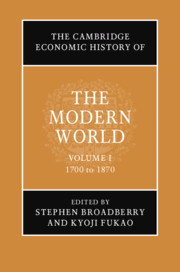Book contents
- The Cambridge Economic History of the Modern World
- The Cambridge Economic History of the Modern World
- The Cambridge Economic History of the Modern World
- Copyright page
- Contents
- Figures
- Tables
- Contributors to Volume I
- Preface and Acknowledgements
- Introduction to Volume I
- Part I Regional Developments
- Part II Factors Governing Differential Outcomes in the Global Economy
- 12 Population and Human Development since 1700
- 13 Proximate Sources of Growth: Capital and Technology, 1700–1870
- 14 Underlying Sources of Growth: First and Second Nature Geography
- 15 Institutions
- 16 Consequences of Growth: Living Standards and Inequality
- 17 International Transactions: Real Trade and Factor Flows
- 18 Monetary Systems and the Global Balance of Payments Adjustment in the Pre-Gold Standard Period, 1700–1870
- 19 War and Empire, 1700–1870
- Index
- References
13 - Proximate Sources of Growth: Capital and Technology, 1700–1870
from Part II - Factors Governing Differential Outcomes in the Global Economy
Published online by Cambridge University Press: 03 June 2021
- The Cambridge Economic History of the Modern World
- The Cambridge Economic History of the Modern World
- The Cambridge Economic History of the Modern World
- Copyright page
- Contents
- Figures
- Tables
- Contributors to Volume I
- Preface and Acknowledgements
- Introduction to Volume I
- Part I Regional Developments
- Part II Factors Governing Differential Outcomes in the Global Economy
- 12 Population and Human Development since 1700
- 13 Proximate Sources of Growth: Capital and Technology, 1700–1870
- 14 Underlying Sources of Growth: First and Second Nature Geography
- 15 Institutions
- 16 Consequences of Growth: Living Standards and Inequality
- 17 International Transactions: Real Trade and Factor Flows
- 18 Monetary Systems and the Global Balance of Payments Adjustment in the Pre-Gold Standard Period, 1700–1870
- 19 War and Empire, 1700–1870
- Index
- References
Summary
This chapter is concerned with two fundamental driving forces of the process of modern economic growth: capital accumulation and technical change. The importance of these factors as drivers of productivity growth underwent a major acceleration with the First Industrial Revolution. This chapter surveys the available evidence on capital accumulation since 1700 in different countries, highlighting the expansion of fixed capital. The chapter then outlines the main contours of technical advances of the First Industrial Revolution, noting the critical role played by two technological trajectories: 1) mechanization, and 2) the development of steam power technology. Finally, the chapter discusses the main sources of technical progress in this historical period, flagging some directions for further research.
- Type
- Chapter
- Information
- The Cambridge Economic History of the Modern World , pp. 312 - 338Publisher: Cambridge University PressPrint publication year: 2021

